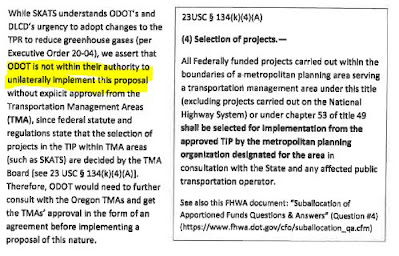At the MPO tomorrow the 26th, there are a number of items to note.
 |
| City to fund walking safety projects |
In a letter to the MPO, the City said they plan use their allocation of Covid relief funds, just shy of $1 million, "to construct pedestrian safety projects." That should fund at least a few new enhanced crosswalks! (Hopefully the City will plan for sites in addition to ones already planned, and will not merely shift the source of funding so that funds that had been allocated to crosswalks would now go to more autoist projects.)
Also on the agenda is conversation about how to score and prioritize project applications in the next round of discretionary funding in the TIP, for 2024-2029.
 |
| How should we score project applications? |
What's a TIP, you ask? From the MPO project site on the call for applications:
The Salem-Keizer Area Transportation Study (SKATS), the Metropolitan Planning Organization (MPO) for Salem-Keizer-Turner, is soliciting for sponsors of transportation projects within the SKATS MPO boundary to apply for federal funds for the federal fiscal years (FY) 2024-2029 Transportation Improvement Program (TIP). There will be approximately $13 million in federal funds available for new projects in FY 2025, 2026, and 2027 and an additional $12 million available for projects ready for contract in the FY 2028-2029 illustrative years; although, it is up to the SKATS Policy Committee’s discretion to program funds for those years. Projects eligible for funding must be within the SKATS MPO boundary and be included in, or consistent with, the 2019-2043 Regional Transportation Systems Plan (RTSP). Applicants must be a tax-funded public agency that can enter into a contract with the Oregon Department of Transportation (ODOT), with some restrictions, to be eligible to receive funding. A minimum 10.27 percent match with non-federal dollars is required. Private entities or non-profit organizations may apply as co-applicants in partnership with a public agency.
In a separate topic and agenda item, but conceptually linked, in defending the historical approach to prioritization and project selection, they suggest nearly a third of funding remaining after some non-discretionary categories are taken out has gone to "complete street" projects that are "mostly bike/ped." These are often taking a two-lane street and adding a center turn pocket and also sidewalks and bike lanes. (See diagram below.) To say they are "mostly bike/ped" has seemed here like an exaggeration generally: The center turn lane widens the street, adds auto capacity, and makes for longer crosswalks. But this is one of those debates on which reasonable people can disagree and may not be possible resolve definitively.
 |
| "Complete streets" |
 |
| From two lanes to three Current design standard (TSP, Jan. 2020) |
Here's the list from the last cycle of funding. An example of disagreement might be the approach to McGilchrist (the specific project is just a part, the intersection with 22nd). McGilchrist is going to get sidewalks and bike lanes, so it would be counted as a "complete street." Yet it is mainly for freight. It will likely remain signed for 40mph, the bike lane is currently set to be a painted strip only, and it's going to be a facility mainly for strong and confident people or those who have no choice, and will meet no family-friendly standard. Just how "complete" it is, and how fully it should count as a primarily a bike/ped project, will also remain a matter of opinion and debate.
 |
| The full project list from 2021-2026 cycle |
In a footnote, the MPO says that ""the largest vehicle capacity expansion in the SKATS area over the last 25 years has been ODOT's widening of Interstate-5 through Salem."
This is surely true, but that doesn't really help us analyze and understand urban streets, and is a little bit of a greenwashing move to make the MPO sound more friendly to non-auto travel. And if SKATS is going to point to ODOT as the biggest offender in "vehicle capacity expansion," they might have mounted a critique of the recent plans for widening between Salem and Albany, especially the Kuebler-Delaney Road segment.
Maybe there's a change of heart underway, but the full context for that table on "complete streets" is an update on and criticism of DLDC/ODOT rulemaking on climate and greenhouse gas emissions. The MPO appears again to want to slow-walk the rules, in a formal letter to ODOT saying "ODOT is not within their authority to unilaterally implement this proposal."
 |
| Resisting greenhouse gas and climate rules |
Probably they have some real points about coordination between Federal and State regulatory requirements. But rather than a framework of positive effort to make it work out, the letter offers a false kind of amity: "we are [not] adversaries in trying to achieve quality, complete systems for all transportation modes in our region." But note that they don't say anything about "reducing emissions." Instead it's the false balance of "complete systems." A certain skepticism and doubt seem warranted here.
Finally, at a time when the Public Participation Plan is out for a 45 day period of public comment, the agenda and meeting packet was an image file whose text could not be searched or copied. Maybe someone is on vacation, or there was a technical problem, and it's not that big a deal, but handling the packet this way isn't exactly conducive to public participation.
The Policy Committee zooms tomorrow, Tuesday the 26th, at noon. The agenda and packet can be downloaded here.
 |
| Meeting information |


1 comment:
(Edit: Added "minor arterial" cross-section to illustrate "complete street" widening.)
Post a Comment